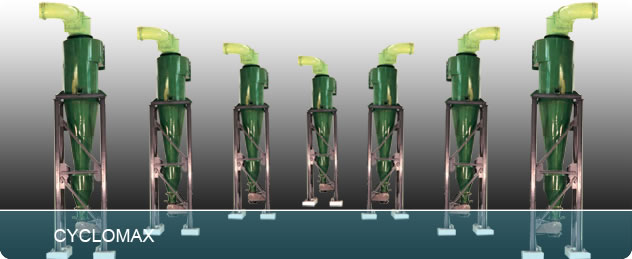Since its inception, Thermax APC division has a product basket that included mechanical dust collectors. Today it enjoys a big installation count, that has crossed the 6000 mark. In a Cyclomax, dust laden gas enters the upper cylinder tangentially, and moves down  the conical section in a spiral path. The centrifugal force thus developed makes the dust particles move radially outward. They then strike the wall and drop out of the gas stream into the hopper. Clean gas flows out through the exit tube. Designing the Cyclomax T-T is a state-of-the-art technique. Specific application parameters like the dust load, gas  velocity, dust characteristics, particle size distribution and the overall system decide the optimum cyclone geometry and the internals. Factors such as length of the outlet tube inside the cyclone, length of the cylindrical portion, inlet and outlet areas, deflectors, length of conical portion etc. play an important role in determining the performance of the cyclone. Proper consideration of all these ensure a high collection efficiency, enhanced product (resource) recovery and very low emission levels, which is not possible in conventional cyclones. For boiler applications it is possible to achieve emissions as low as 300 Р350 mg/Nm for agro-waste (husk) firing, which makes the Cyclomax suitable as a final collector. This equipment from the Thermax stable was instrumental in providing an economical  answer to the problem of handling fly-ash in husk fired fluidised bed boilers in the Punjab-Haryana belt, when norms of the above order were first introduced. Today, a multitude of users, spread across the country, bear testimony to the efficiency and success of this equipment.
Versions of Cyclomax
With increasing gas volumes, it is difficult to obtain the desired dust collection efficiency in a single cyclone construction. Thermax can configure high efficiency cyclones into various versions – twin (two cyclones), quad (four cyclones) and double quad (eight cyclones) with the help of computer aided simulations to achieve higher efficiencies.
Optimisation of dimensions to ensure maximum efficiency remains the basic approach in the final selection of any of these versions. Application requirements and site conditions are other important selection factors that influence the choice of an appropriate version.
For special applications like the fertiliser industry, individual collection hoppers with each cyclone in twin/quad version are provided instead of common hoppers. This prevents dust re-entrainment and facilitates free dislodging of dust from the hoppers. Dust discharge is effected through a motorised leak proof double flap dump valve or a rotary air lock valve.
- Can handle gas volumes from 2000 m3/hr onwards
- Application based material selection and special lining options to handle a wide variety of dust
- Specially deigned for high efficiency of collection
- Unique outlet tube design with pr. Drop control by varying outlet velocity –future efficiency enhancement possible by changing outlet tube.
- Partial sectionalisation possible in twin and quad designs-also effective for part load operations.
- Adequately sized rotary airlock valve for dust discharge, to ensure air-seal and free dust discharge from the hopper.
- Typical applications-boilers, wood products, sugar, fertilizers, cement, metal fines etc.





 Call Us Now
Call Us Now